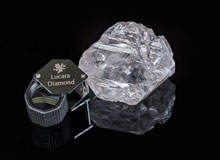
The Cullinan Diamond – 3,106ct
The Cullinan Diamond, the world’s biggest non-carbonado gem-quality diamond ever found, weighed 3,106ct in its uncut state and measured 10.1cm x 6.35cm x 5.9cm. The diamond was discovered at the Premier Mine near Pretoria in South Africa in January 1905. It is named after Thomas Cullinan, the mines owner.
The rough diamond was cut by IJ Asscher into nine numbered stones, 96 small brilliants and 9ct of unpolished fragments. The biggest two gems are set in the Sovereign’s Sceptre and the Imperial State Crown, both belonging to the UK Royal Family.
Karowe AK6 Diamond – 1,111ct
The Karowe AK6 Diamond, which weighs 1,111ct and measured 65mm x 56mm x 40mm in size, is a Type IIa diamond recovered in November 2015 from Lucara Diamond’s Karowe diamond mine in Botswana. An 813ct stone was also recovered in the same month. The weight of the latter is, not yet known however as it is yet to be cleaned, placing it for the moment outside the tope ten.
The 1,111ct Karowe AK6 diamond is touted to be the biggest ever diamond recovered through a modern processing facility. The diamond originated from the mine’s South Lobe pipe, which accounts for approximately 75% of the mine’s potential resources.

Excelsior Diamond – 971¾ct
The Excelsior Diamond weighed 971¾ct (194.2g) and measured approximately 5.86cm x 5.47cm, with a thickness between 2.4cm and 8.1cm. The blue-white tint diamond was discovered in June 1893 at the Jagersfontein diamond mine in the Orange Free State, South Africa.

US Tariffs are shifting - will you react or anticipate?
Don’t let policy changes catch you off guard. Stay proactive with real-time data and expert analysis.
By GlobalDataThe diamond was cut by IJ Asscher in 1908 to smaller brilliants, which were primarily sold to anonymous customers in London and America, with the only known purchaser of three diamonds being Tiffany & Co of New York.
Star of Sierra Leone – 968.9ct
The 968.9ct Star of Sierra Leone gem-quality diamond was discovered at the Diminco fields within the Koidu region of Sierra Leone in February 1972. It was purchased by Harry Winston and was first cut into an emerald shape weighing 143.2ct by Harry Voss.
An internal flaw in the diamond further necessitated the stone being re-cut into 17 different diamonds, 13 of which were flawless.

The Incomparable Diamond – 890ct
The Incomparable Diamond, contained in a rough stone that weighed 890ct, was found by a young girl in the Mbuji-Maya district of the Democratic Republic of Congo (formerly Zaire) in a pile of rubble from the neighbouring MIBA Diamond Mine in the early 1980s.
It was jointly acquired by Marvin Samuels of Premier Gem, New York and Louis Glick of Rose Trading, New York and Hong Kong. The former developed the rough stone into a 407.48ct polished diamond and 14 other smaller diamonds.
Koh-i-Noor – 793ct
With a history dating back 5,000 years, the Koh-i-Noor diamond (translated as the Mountain of Light), which originally weighed 793ct, is one of the oldest known gems. It was unearthed from the Kollur mine in Guntur district of Andhra Pradesh, India.
The historic diamond was first cut during the Mughal era by Hortense Borgia, a Venetian lapidary, who reduced the weight of the stone to 186ct. The diamond went into the hands of the British Royal family in 1850 and was further cut in 1852 and used in the Crown of Queen Victoria, under the supervision of James Tennant, reducing it to its current weight of 106ct.

Great Mogul Diamond – 787.5ct
The Great Mogul diamond, which originally weighed 787.5ct, is believed to have been discovered from the Kollur mine in 1650. The diamond was gifted to the Mughal Emperor Shah Jahan by Emir Jemla, a wealthy general.
Venetian lapidary Ortenso Borgio was tasked with cutting the fine stone, which resulted in a drastic weight reduction, in his attempt to address the stone’s inclusion problem. The diamond’s whereabouts are now unknown following the assassination of its last owner, Nadir Shah, in 1747.
Millennium Star – 777ct
The Millennium Star diamond, which weighed 777ct at the time of discovery, was unearthed from the alluvial deposits of Mbuji-Mayi mines in Zaire (now Democratic Republic of Congo) in 1990.
Acquired by De Beers during the civil war in the early 1990s, the diamond was cut into a pear-shape by Steinmetz Diamond Group, a process that took approximately three years. The finished product unveiled in 2000 is known as the De Beers Millennium Star, a color grade D flawless stone weighing 203.04ct.

The Woyie River Diamond – 770ct
At 770ct, the Woyie River diamond is the second biggest alluvial diamond ever found. It measured approximately 71mm x 53mm x 32mm in its rough form. The lozenge-shaped diamond was recovered in January 1945 by the recovery plant operated by Sierra Leone Selection Trust in the Woyie River, Sierra Leone.
The company entrusted Briefel and Lemer of London to cut the rough diamond in 1953. It was cut into 30 gems, with the biggest of the lot weighing 31.35ct. Named the Victory Diamond, it is currently up for auction at Sotheby’s in New York.
The Golden Jubilee Diamond (Unnamed Brown) – 755.5ct
The Golden Jubilee Diamond (formerly Unnamed Brown Diamond), which weighed 755.5ct in its original state, was discovered in 1985 at the Blue Ground area of De Beers’ Premier Mine in South Africa. Gabi Tolkowsky was given the charge to design, cut and polish the stone, which was subsequently shaped into a 545.65ct yellow-brown cushion cut diamond, making it the world’s biggest cut and faceted (148 facets) diamond.
The Golden Jubilee diamond was sold by De Beers to a group led by Henry Ho of Thailand, who later presented it to HM King Bhumibol Adulyadej of Thailand to commemorate his 50 years on the throne. It is currently in the Royal Thai Palace within the Crown jewels collection.



